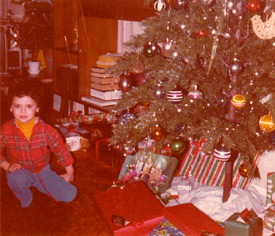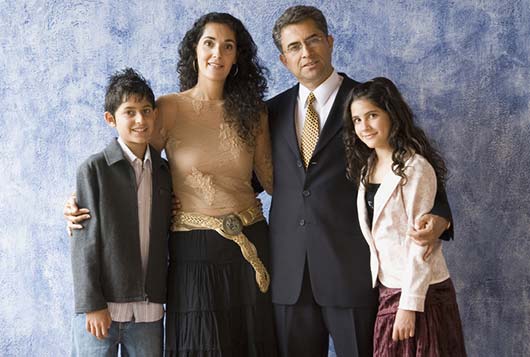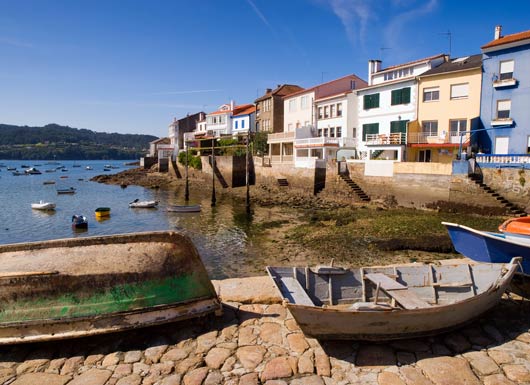
Should you bust the Santa Claus myth with your kids?
It was the early eighties. I was in first grade, sitting on a school bus on a class trip, reading a book. The bus pulled to a stop at a traffic light, and one of my classmates looked out the window and shrieked, “It’s Santa Claus!”
Everyone with a window seat pressed their faces against the glass. There, outside a Woolworth’s, was an African-American man dressed as Santa, ringing a bell and collecting for the Salvation Army.
That’s not Santa Claus,” said another classmate, a little blond girl. Santa is white.” “No, he isn’t,” piped up my best friend, who was sitting next to me but had craned her neck to look out the window. “Santa’s black!” An argument started. I looked on pityingly. Finally, I decided to help out. “Santa’s not white or black,” I said loudly. “Santa doesn’t exist, so he’s neither.”
There was a stunned silence, and the bus lurched forward. Pleased that I had successfully squelched the argument, I went back to reading my book. Yes, I was that little girl—the girl who never believed in Santa Claus, the girl who ruined it for everyone else.
FINDING OUT THE TRUTH
Recently, a story made the news about a teacher in New York who told her students that there was no such thing as Santa Claus. The teacher was vilified; parents were in an uproar. But when I heard the story, I saw the teacher as being more truthful than treacherous, more sensible than sinister.

Even at this young age, I knew who was really leaving the presents under the tree.
I grew up in New York City, the daughter of an artist and a therapist—two practical-minded people who didn’t believe in telling their children anything that wasn’t true. Hence, at a very young age, when I asked my mother if she was ever going to die, she said—gently but firmly—Yes. “Where will you go when you die?” I asked, shaken. “No one knows,” she said. Yikes!
In an atmosphere of this kind of truth-telling, Santa never had a chance. Oh, early on, I had my doubts about him, as we lived in an apartment building with no fireplace, no chimney, and a doorman who made visitors say their names before letting them upstairs. So I went to my parents, who immediately disabused me of the notion that the jolly Saint Nick existed. It was a simple conversation. I said, “Is there a Santa Claus?” My parents answered, “No.” And my doubts were confirmed.
After that, it was with pity—and yes, a bit of contempt—that I looked upon my classmates when they nattered on about what “Santa” was going to get them for Christmas. Even before I knew The Truth, I had noticed major flaws in the whole story of Kris Kringle—such as the fact that my presents were always labeled in my mom’s handwriting. So why weren’t my friends drawing the same conclusions?
The years went on; I reached adulthood, and didn’t give Santa a second thought. That is, until I met my partner, Joseph, and his three children from a previous marriage. I realized—fortunately, before I put my foot in my mouth—that the kids firmly, completely, and absolutely believed in Santa. The breakup of their parents’ marriage had done nothing to dispel this belief. “Santa leaves some presents at Mommy’s, and some presents at Daddy’s,” Joe’s daughter told me confidently. I changed the subject.
TO TELL OR NOT TO TELL?
Now the subject has come up again; Joe and I have a son of our own, CC.
Last Christmas, he was just a baby, but the concept of Santa still reared its red-hatted head. Joe figured we’d be carrying on his family tradition of perpetuating the whole idea, and I figured we’d be doing no such thing. We had—not an argument—but a discussion about the whole thing, and it seemed a little hopeless. So we made a brave, mature decision—we decided to table the discussion indefinitely. We both breathed a sigh of relief that we could put it off a little while longer.
This Christmas, CC will be sixteen months old, still too young to understand Santa, but he’s getting close. So, on a walk in Prospect Park on an unusually mild November morning, Joe and I broached the subject once again. It helped me to understand Joe’s family history. Raised Irish-Catholic, an altar boy who grew up with three brothers in a big house in the suburbs, he not only believed in Santa, but cherished the story and felt it was an integral part of the spirit of Christmas. The North Pole, the helpful elves, a pink-cheeked Mrs. Claus, the “naughty or nice” list—he saw it all as a charming story that embodied what is so special about the holiday. Yes, he admitted he felt hurt when he learned The Truth, but he got over it, and still regards it as a vital part of Christmas for children. It helped Joe, too, to understand my family history—that having never believed, I felt uncomfortable telling the story to our son as though it were the truth. It felt like a lie, and I wanted to be honest with CC.
A CHRISTMAS STORY
In a situation as seemingly hopeless as this, it was inevitable that the word “compromise” be introduced into the discussion. But I think we found a true compromise. I’ve agreed to tell CC the tale of Santa Claus as a story, not as fact. And when CC asks me if Santa is real, I’m allowed to tell him no—as long as I explain that the story, while not actually the truth, is a special part of Christmas. I think it’s going to work. Joe gets to share Santa with CC, and I don’t have to lie. And this in itself is a bit of a Christmas story, after all. Hearing Joe talk about how important the spirit of Christmas is to him, and to his family, made me think of what I realize now was my serious faux pas aboard the school bus all those years ago. My best friend, who was African-American, believed in a Santa Claus that looked like a member of her family, while the little blond girl imagined a Santa who looked more like a member of hers. The truth is, the spirit of Christmas—stories told by parents to children; cookies left out for a nighttime visitor bearing gifts; the magic of wrapped presents waiting to be opened under a fragrantly pine-scented tree—belongs to anyone who wants to celebrate Christmas. So my announcement to my classmates that “Santa doesn’t exist, so he’s neither,” wasn’t really true after all. “Santa doesn’t exist, so he’s both,” would have been more appropriate. Santa can be black or white, real or not, or whatever makes the story magical to whoever wants to believe. And that really is the spirit of Christmas.











